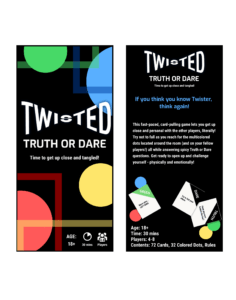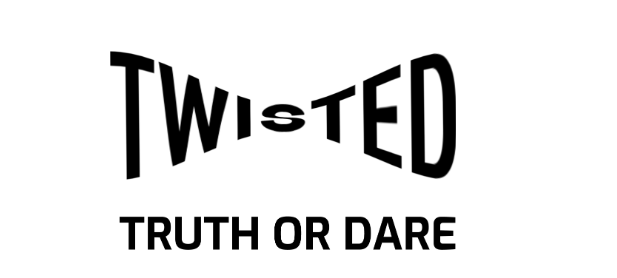Artist’s Statement
We designed Twisted Truth or Dare with the intention of bringing some of the best parts of party games—fellowship and exploration as you learn more about the people around you—to the childhood classic Twister. During brainstorming, we realized that classic Truth or Dare questions would add an exciting, more adult element to the game, and could stand up to the fast-paced nature of Twister (and would still be fun to play drunk!).
Ultimately, we built Twisted Truth or Dare: a fast-paced, card-pulling game that expands the Twister board to the space around players—and the players themselves—and alternates Twister challenges with Truth or Dare questions that prompt players for everything from embarrassing stories to their first impressions of each other. To accommodate players who know each other well, we included a “Spicy” pack of questions. The rules are simple: the last person standing wins— if you fall or refuse a question, you’re out! We hope Twisted Truth or Dare poses a slightly silly physical challenge while making all of the players laugh, engage in friendly competition, and (of course) get to know each other just a little bit better.
Concept Map:
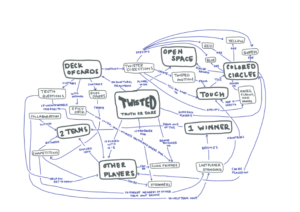
Ideation Exploration:
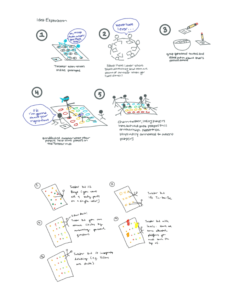
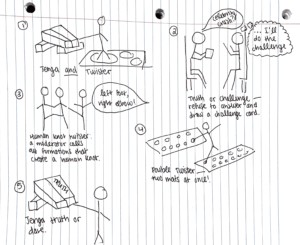
Initial Decisions about Formal Elements and Values
In our initial design, our biggest decision was that we wanted to eliminate the limitation of a Twister mat, so instead we decided that the mat would be the other players! This meant the spinner would instead contain the player names and we would specify which body part players needed to touch. This decision encoded our value of intimacy through uncomfortable positions. We wanted this game to help friends let down their boundaries and grow closer. Players are encouraged to physically get close through Twister, emotionally open up by answering truthful questions, and push themselves outside of their comfort zone through fun dares.
The game was designed to be played by 5-8 players in player vs. player competition – every player tries to preserve themselves to be the last one standing in the game. In terms of resources, the only resource was the other players! Since the game requires you to use the other players as the Twister mat, the other players are given the power to help or sabotage each other. In other words, the main conflict in the game is the obstacle created by maintaining contact with other players while answering tough questions or completing challenging dares. The obstacles change each time the game is played based on the players and the shuffling of the deck. Players self-eliminate by failing to do a twister move or refusing a truth or dare, making the objective of the game to outlast the other players.
We designed this game for two core types of fun: fellowship and challenge. The three core elements of the game: Truth, Dare, and body part Twister, were intentionally chosen with these types of fun in mind. Fellowship is brought about through Truth questions and Twister prompts. Truths allow players to share things about themselves and get to know each other. Twister forces players to physically connect through the shared experience of being put in wild, goofy positions. Lastly, Challenge is incorporated through Dares which we intended to push players out of their comfort zone and encourage them to take themselves less seriously.
Testing and Iteration Process:

First Playtest
Set up:
As detailed above, our original game had players draw cards that specified either a truth, a dare, or a body part. If a body part was drawn, players used a spinner (with all player names written on it in dry-erase) to select a person. Then, all players would need to maintain contact with that person’s body part for the rest of the game. Our low-fi prototype used index cards and a cardboard spinner laminated in tape. We playtested on four students in class who did not know each other. Our goal was to determine whether touching other people’s body parts made players too uncomfortable and if the game was leaning too difficult or too easy.
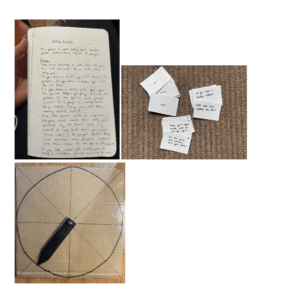
Went Well:
Our first playtest validated the fundamental concept of our game: players were laughing and engaged in the act of bodily Twister. They did not show hesitation or discomfort touching other players’ body parts as part of the game. While playing, a few remarked on “how fun” the idea for the game was. We saw them develop fellowship, laughing together as they turned into a tangled clump of arms.
Needs Improvement:
Seeing our game played out physically made us realize that several of our rules needed to change. Having everyone touch the person’s body part that is drawn made the game end too quickly: players were all tied up after only a few body part cards were drawn. It was too difficult and limiting to allow players to get into meaningful, dynamic gameplay.
Iteration:
We changed the rules so that only the person who draws the twister card needs to engage in the twister activity. Other players are not involved. This should make the game easier.
Second Playtest
Set up:
Our setup was identical to that of the first playtest, with the same low-fi prototype. We made our small rule alteration and wanted to test whether that made the game more engaging and dynamic. We were also looking to test the content of our truth and dare cards: were the truths interesting? Were the dares funny or too intense? We playtested with a group of 3 people in class who were strangers.
Went Well:
Players remarked that the game was fun and they’d want to play it multiple times. The change we made to the rules was positive: it made the game last longer and more conflict arose between players because they had to engage in different acts.
In this playtest, we didn’t include the “spicier” cards in our deck to see how this would change the tone of the game. We showed the playtesters these cards afterwards to get their reactions and they gave intense verbal reactions (exclaiming “Oh my god”). They felt it was a good choice to remove these cards from the deck for a group of strangers, but they would be fun to use with close friends.
Needs Improvement:
The players did not end up getting very twisted because we did not specify which part of their body they needed to use to touch other players. They could often find a way to move their hands into a comfortable position, or have the other person shift to accommodate them. Players never got “out” by falling or being unable to touch someone, which is not how a game of Twister should go! We wanted to make the game harder by specifying which body part players need to use. I will detail the changes we made in the following section.
The use of spinner and cards was somewhat clunky. The moderator ended up having to hold up the spinner just so players could reach it. The spinner itself was imperfect: when a player was eliminated, their name was still on the spinner. We decided it would be best to remove the spinner from the game.
Iteration:
We decided to have a separate “spicy” deck that players can choose to incorporate into the deck when playing with people they are more comfortable with.
To make the game harder, we made some updates to our basic rules. We decided that at the start of each game we’d give players 4 colored dots each (like those on a Twister mat) and allow them to place them on their bodies or around the room with tape. This makes the game of Twister harder, more varied, and allows players more freedom in what parts of their body they are comfortable having touched. Twister cards now specify a color of dot and the body part the drawer needs to use to touch the dot. Adding this requirement makes the game more difficult, as we wanted. It also allows for greater creativity. Finally, it eliminates the need for a spinner.
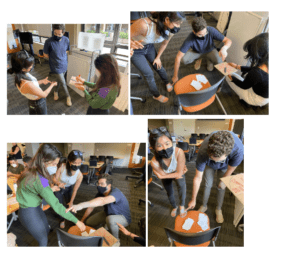
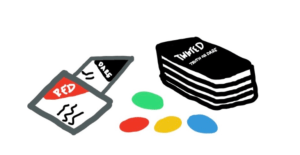
Third Playtest
Set up:
For this playtest we printed out Twister dots and a new set of hi-fi cards that specified either a truth, dare, or a color and body part. We wanted to test whether this new implementation of our concept made the game harder so that people got “out” and whether players were committed enough to twist themselves to win the game. We tested with 6 people in class who were strangers.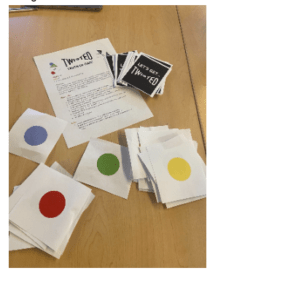
Went Well:
This run of the game was very fun, in part because the group was larger. Players were laughing throughout. They were also very committed to winning the game even when twisted in really uncomfortable positions. Allowing them to place dots around the room and on themselves allowed for more creativity and excitement: one player tried to place his dot on the ceiling! The Twister cards were much more challenging in this game; players actually got “out” from Twister, which was our goal.
Since we eliminated the spinner, the game ran more smoothly and didn’t require our interference. Players were good about passing around the cards to keep the game going.
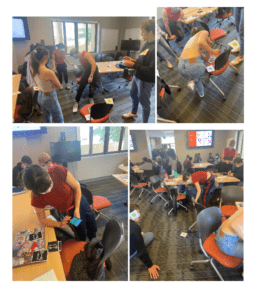

In terms of truth cards, players enjoyed the get-to-know-you, first-impression style questions when playing with strangers. For dares, players enjoyed how challenging the physical dares were. We want to incorporate more of both these styles of card in our next iteration.
Needs Improvement:
Some players were initially confused by the rules. They did not realize they actually needed to touch the dots; others thought they could move the dots around. We will be clearer in the rules to specify these details and not assume people know the rules of Twister.
Players desired more control in the game. They suggested the idea of gameplay cards, like a “pass it on” or “skip” card to use on truth/dares. We think this is a good idea to add complexity and conflict to the game.
The biggest issue in this iteration is that there was almost too much collaboration. Players did a lot of work to help each other stay in the game when they ended up in difficult Twister positions. This prevented some interesting competitiveness and conflict that could have arisen.
Iteration:
Our biggest final change is to divide players into 2 teams at the beginning of the game. Teams collaborate internally to make sure the last man standing is from their team. They can also try to sabotage the other team. This fix maintains the collaboration but adds back in a competitive aspect.
We also added in 6 gameplay cards allowing players to skip/pass on cards. Finally, we updated our description of the rules to give players more clarity on how Twister works.
Video from Final Playtesting;
Link to Final Prototype:
Link to rulebook: https://drive.google.com/file/d/1PBtDm-yZq9ZlyZTlutRd_V3Hd2vuNkHy/view?usp=sharing
Link to cards (print double-sided): https://drive.google.com/file/d/1Uiki1tsFqYWscxh67lDO9dW0-aVyOXDk/view?usp=sharing
Link to dots (print single-sided): https://drive.google.com/file/d/1VuaK48OrOArNAJXITxjjiWU6KZYG71gz/view?usp=sharing
Graphic Design Exploration:
Since we intended for our game to be a physical card game, once we had worked out some kinks in the game mechanics, we turned our energy to designing the branding of the board game box. Since our game was aimed for a more mature audience, we began our design process by exploring the branding of other adult board games. Specifically we looked at games like Cards Against Humanity, For the Girls, Taboo, and adult loaded questions. The main trends we saw in these boxes was a darker color palette, minimalist design, high contrast colors, and bold typography. While the Truth or Dare aspect of the game is self explanatory from the title, we wanted to make sure the Twister element came through clearly in the graphics. To do this, we wanted to highlight the four colored dots and visualizations of “twists”. One aspect of this design was specifically inspired by the Twister box.
While the illustration and coloring on the Twister box is too juvenile for our game, we liked that the “T” in the title has a twist in it to imply the core aspect of the game play. We decided we wanted to play on that idea and visually twist the “Twisted” part of our title, since that is the element of the title that implies the Twister element of the game. We knew we wanted to explore different designs broadly and narrow in, so we played around with dark and light color schemes and different placements of twists and dots. You can see our initial exploration below:
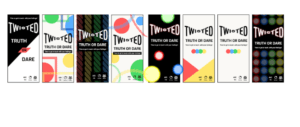
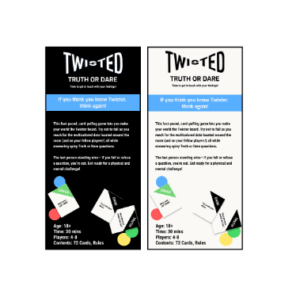
Initial Submission:
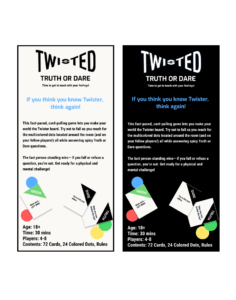
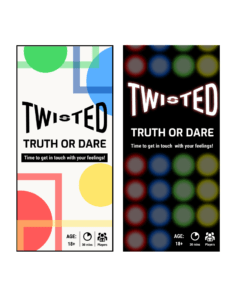
From our initial exploration we narrowed in on a dark and light design that we found most visually appealing and wanted feedback on. We received feedback that the darker design better communicated the “after dark,” mature content of the game, however the grid layout of the colored dots in the dark design implied that there was still a physical twister board. On the other hand the more random placement of the colored dots in the light design was better at communicating the free placement of dots during our game. The other main point of feedback was to clarify our wording. The current tagline “Time to get in touch with your feelings” did not clearly imply the Twister element of the game. In our final box design we combined the best aspects of the dark and light designs into a final dark design. We also shortened the back description and tweaked the tagline to increase clarity.
Final Version:
